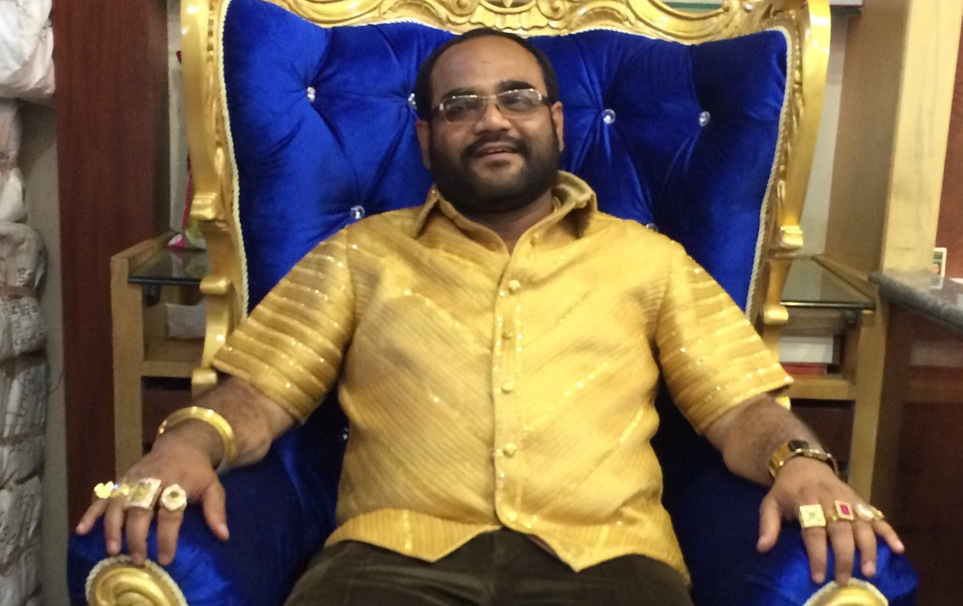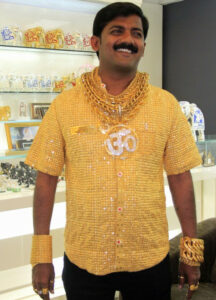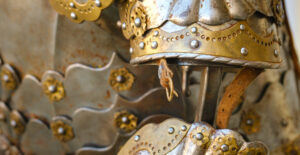
Imagine strolling through your sleepy hometown, when suddenly a man strides by, every bit the picture of confidence and extravagance. But this isn’t any ordinary stroll. His shirt isn’t made of cotton, it’s crafted entirely from pure gold. Welcome to the world of Pankaj Parakh, India’s unforgettable “Man with the Golden Shirt.”
On his 45th birthday, Pankaj Parakh didn’t ask for cake or balloons. Instead, he unveiled a creation that would turn heads across the nation, a shirt made from solid 18K and 22K gold, valued at a jaw-dropping ₹1.3 crore (roughly $240,000). Imagine a shirt that weighs between 3.5 and 5 kilos, soft enough to wear, and lined with cloth so it doesn’t rub against the skin. It took 20 skilled artisans, a staggering 3,200 hours of craftsmanship, and two long months to complete.
Why go to such lengths? Parakh said gold was his passion since youth, joking that while others splashed out on luxury cars, “What crime have I done? I just love gold.”
The Clash of Golden Titans
Pankaj wasn’t India’s first golden-shirted celebrity. That title originally belonged to Datta “Gold Man” Phuge, who made headlines in 2012 after commissioning a 22K gold shirt worth roughly Rs 1.27 crore (about $240,000), complete with Swarovski crystal buttons.
Phuge’s ostentatious fashion earned him a spot in the Guinness World Records and national fame. He was proud of his creation, saying, “Everybody knows me as the ‘gold man” . But the story took a tragic turn, in July 2016, Phuge was brutally murdered during a financial dispute, a shocking end to the man who loved his golden armour.
Enter Pankaj Parakh, determined to one-up Phuge’s gold record, his shirt edged into even more luxurious territory. With his own golden shirt, Parakh hoped not just to break records but to enter the Guinness Book as the most extravagant wearable work of art.
What’s truly remarkable is that this was no rigid metal suit, it was a garment in the truest sense. Artisans managed to keep the shirt flexible, comfortable, and wearable. And despite the gleaming sheen, it was lined internally to prevent irritation and came with a lifetime warranty.
This fusion of technology, patience, and creativity makes Parakh’s shirt more than a status symbol, it’s a marvel of modern craftsmanship.
True to his style, Parakh didn’t showcase his shirt inside some glitzy nightclub or private gala. He took it for a casual stroll through his village near Mumbai, escorted by a discreet yet vigilant bodyguard. The sight of gold-clad sleeves catching the sunlight was sure to have left jaws on the floor and phones snapping photos.
This was a move that merged the everyday with the extraordinary, making him a “walking spectacle” among neighbours and strangers alike.
Who Are These Golden Magnates?
 Beyond the glitter and media frenzy, both Pankaj Parakh and Datta Phuge illustrate a larger view of wealth in modern India, where old traditions of gold as a symbol of status collide with present-day audacity.
Beyond the glitter and media frenzy, both Pankaj Parakh and Datta Phuge illustrate a larger view of wealth in modern India, where old traditions of gold as a symbol of status collide with present-day audacity.
- Datta Phuge (1968–2016) built his empire through chit funds and financial institutions in Pune. His gold shirt was an emblem of his success, and perhaps his undoing.
- Pankaj Parakh, meanwhile, emerged from garment manufacturing. His gold flamboyance speaks to an evolving narrative: when one golden shirt is no longer enough, make another. Bigger, bolder, and even more gold.
They’re living symbols of how gold remains deeply embedded in Indian cultural and economic life, used not just for jewellery or weddings, but as a canvas for ambition and spectacle.
Guinness or Nothing
Both men eyed the Guinness Book of World Records with laser focus. Phuge’s golden statement already sat comfortably in record books. Parakh’s move was a calculated next step, to claim, rightly or not, the title of “world’s most expensive shirt” .
Whether Guinness officially recognised him is unclear. But the claim, and the viral buzz, was enough to secure the gold-laced legend in pop‑culture lore.
At 3.5–5 kg, the shirt tipped the scales as much in gold value as it did literally. To put that into perspective, 1 kg of 24K gold today is worth about $65,000, so at 5 kg, the shirt could cross $325,000 That’s not just conspicuous consumption, it’s a bold statement of identity, turning wearable art into a billboard of taste, wealth, and creativity.
In 2025, this legendary golden shirt remains a benchmark for audacious luxury. It reminds us that:
- Human nature still craves spectacle. Parakh’s stroll, Phuge’s flash, these are shared memories because they were unexpected, bold, and undeniably human.
- Gold remains symbolic. In India, it’s more than a commodity, it’s a carrier of meaning, prestige, and sometimes, rivalry.
- Art meets ambition. These shirts weren’t just heavyweight statements, they were engineered and artistic marvels, blending design, craft, and daring.
More Than Just a Shirt
The story of India’s Golden‑Shirted men is more than a bizarre headline, it’s a window into how tradition, wealth, art, and identity collide. These shirts shimmer not just with gold but with human spirit: ambition, showmanship, even absurdity.
Parakh’s sunlit walk, Phuge’s tragic demise, the Guinness chase, these are chapters in a tale that reads like myth. It’s a story we remember because it defies expectations. And in a world glutted with clever marketing and digital noise, sometimes a man in a gold shirt is exactly what we need.



